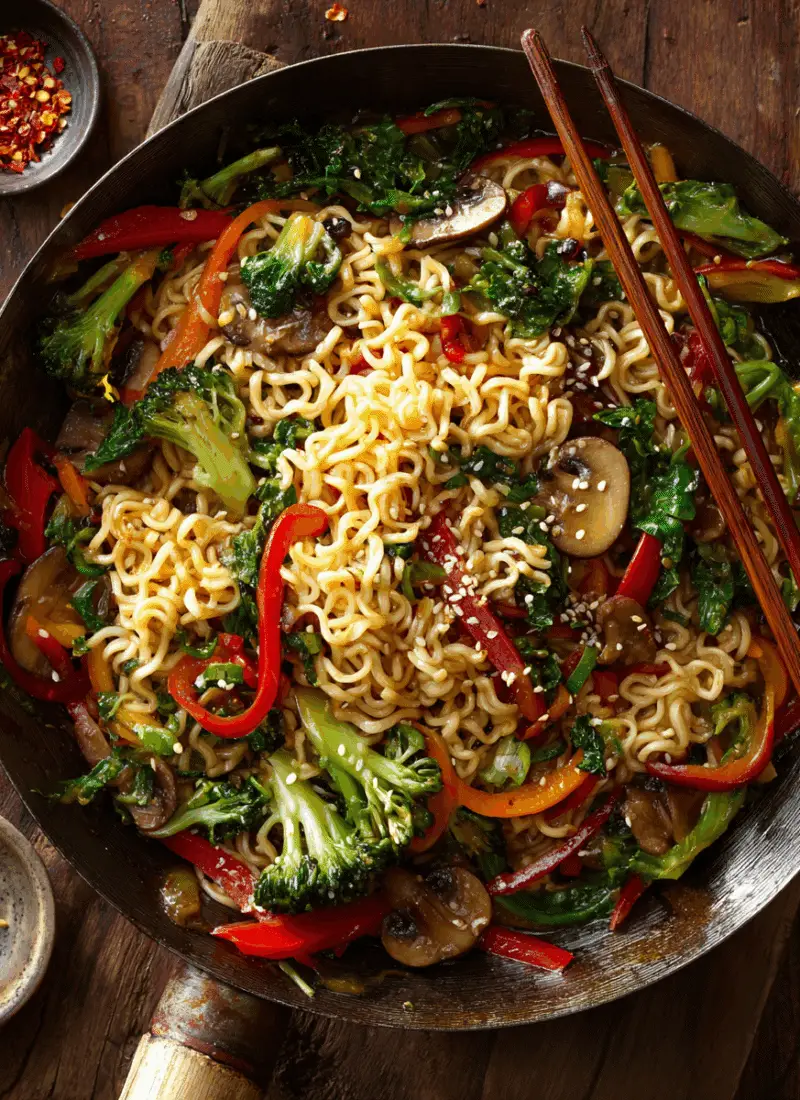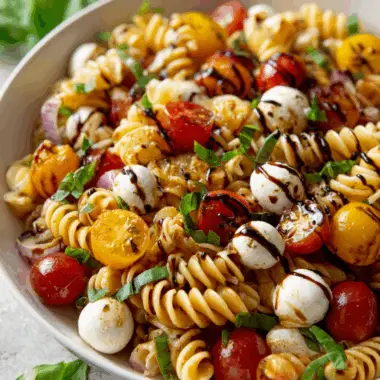This Ramen Stir-Fry is the ultimate budget-friendly weeknight dinner that doesn’t sacrifice flavor. With simple ingredients, minimal prep time, and a delicious sauce that brings everything together, it’s an easy favorite for students, busy families, or anyone craving a fast and satisfying meal. The chewy ramen noodles soak up a savory, slightly sweet stir-fry sauce, while crisp vegetables and protein of your choice add texture and substance.
FULL RECIPE
Ingredients
- 2 packs instant ramen noodles (discard seasoning packets)
- 2 tablespoons vegetable oil
- 2 cloves garlic, minced
- 1 cup shredded carrots
- 1 cup broccoli florets
- 1 red bell pepper, thinly sliced
- 2 green onions, chopped (optional for garnish)
- 2 eggs, lightly beaten (optional)
- 1 tablespoon sesame seeds (optional)
1.For the sauce:
- 3 tablespoons soy sauce
- 1 tablespoon oyster sauce (or hoisin for vegetarian option)
- 1 tablespoon brown sugar
- 1 teaspoon sesame oil
- 1/2 teaspoon ground black pepper
- 1/2 teaspoon red pepper flakes (optional)
Directions
- Boil ramen noodles according to package instructions, but reduce cooking time by 1 minute. Drain and set aside.
- In a small bowl, mix all sauce ingredients and set aside.
- Heat vegetable oil in a large skillet or wok over medium-high heat.
- Add garlic and stir-fry for 30 seconds until fragrant.
- Add carrots, broccoli, and bell pepper. Stir-fry for 3–5 minutes or until veggies are slightly tender but still crisp.
- Push veggies to the side and pour in the beaten eggs. Scramble until fully cooked, then mix with the vegetables.
- Add the cooked ramen noodles to the skillet. Pour the prepared sauce over the top.
- Toss everything together for 2–3 minutes until the noodles are coated and heated through.
- Garnish with green onions and sesame seeds if desired.
- Serve hot and enjoy!
Nutrition Facts
- Calories: 460
- Total Fat: 20g
- Saturated Fat: 3g
- Cholesterol: 120mg
- Sodium: 1250mg
- Total Carbohydrates: 55g
- Dietary Fiber: 5g
- Sugars: 9g
- Protein: 14g
- Vitamin A: 120% DV
- Vitamin C: 80% DV
- Calcium: 6% DV
- Iron: 15% DV
Nutritional Benefits of Homemade Ramen Stir-Fry
Although instant ramen is often viewed as an unhealthy option, preparing ramen stir-fry at home significantly upgrades its nutritional value. By skipping the sodium-heavy seasoning packet and making your own sauce, you control the salt and sugar content. Adding a generous portion of fresh vegetables such as broccoli, carrots, and bell peppers boosts the dish’s fiber, vitamin, and antioxidant levels. Including lean proteins like eggs or tofu introduces essential amino acids and balances the carbohydrates in the noodles. With the right ingredients, ramen stir-fry becomes a well-rounded meal that can fit into a healthy diet.
Best Vegetables to Use for Stir-Fry
The beauty of ramen stir-fry lies in its flexibility, especially when it comes to vegetables. Broccoli florets add crunch and a high dose of vitamin C, while bell peppers bring sweetness and color. Carrots lend natural sweetness and beta carotene, making them perfect for contrast against the savory sauce. Other great options include snap peas, shredded cabbage, spinach, baby corn, or mushrooms. The key is choosing vegetables that maintain some texture after a quick sauté. Mixing colors and textures not only improves the visual appeal but also ensures a broader nutritional profile.
Customizing with Proteins
Ramen stir-fry works with almost any protein, making it easy to adjust based on dietary needs or pantry availability. Scrambled eggs are a classic, affordable option that adds richness and a soft texture. For a heartier version, try adding cooked chicken breast, thinly sliced beef, shrimp, or tofu. Plant-based proteins like edamame, tempeh, or seitan also work well for vegetarian or vegan adaptations. The sauce clings beautifully to most proteins, enhancing their taste without overpowering their natural flavor. This protein flexibility ensures the dish is both satisfying and suitable for a range of diets.
Making the Sauce from Scratch
A standout feature of this ramen stir-fry is its homemade sauce, which brings together salty, sweet, and umami elements. Soy sauce provides the salty base, while oyster or hoisin sauce adds complexity and depth. Brown sugar softens the edges with a touch of sweetness, and sesame oil delivers a nutty aroma that elevates the whole dish. Optional additions like garlic, ginger, or red pepper flakes can intensify the flavor further. Crafting your own sauce means you avoid the additives and preservatives often found in packaged alternatives and can tailor the flavor profile to your personal preference.
Budget-Friendly and Pantry-Friendly
This recipe is a lifesaver for anyone cooking on a budget. Instant ramen is one of the cheapest staple items on the market, and the rest of the ingredients—vegetable oil, soy sauce, sugar, and basic veggies—are also highly affordable and shelf-stable. Many of the components can be found in your pantry or freezer, reducing the need for frequent grocery trips. Leftover produce or odds and ends from your fridge drawer find a perfect home in this stir-fry, minimizing food waste. Whether you’re a student, a busy parent, or simply trying to cut back on expenses, this meal delivers big value for minimal cost.
Tips for Perfect Stir-Fry Texture
Achieving the ideal texture in ramen stir-fry requires attention to timing and heat. Vegetables should be cooked over medium-high heat just until crisp-tender to maintain their bite and color. Overcooking them can result in a soggy stir-fry that lacks freshness. Noodles should be slightly undercooked before stir-frying to prevent them from becoming mushy once they soak up the sauce. Tossing the noodles quickly with the sauce ensures they’re evenly coated and retain a bit of chewiness. Using a large pan or wok prevents overcrowding and encourages even heat distribution, helping each component cook to perfection.
Serving Suggestions and Pairings
Ramen stir-fry is a complete meal on its own, but you can easily enhance the experience with complementary sides or toppings. For added crunch, consider topping with roasted peanuts or sesame seeds. A drizzle of sriracha or chili oil amps up the spice for heat lovers. To round out the meal, serve alongside a light soup such as miso or a small Asian-style salad with a sesame vinaigrette. A cup of green tea or a light fruit-based drink like iced lychee tea makes a refreshing beverage pairing. For kids, keep it simple and serve with sliced cucumber or apple wedges.
Make-Ahead and Storage Advice
One of the best things about ramen stir-fry is its potential for meal prepping and easy storage. Once cooked and cooled, leftovers can be stored in an airtight container in the fridge for up to four days. The flavors often deepen overnight, making next-day servings even more delicious. Reheat gently in a skillet or microwave with a splash of water or extra sauce to restore moisture. To prep ahead, chop vegetables and mix the sauce in advance so cooking is streamlined. This dish also freezes well in individual portions for quick meals during a busy week.
Popular Variations Across Cultures
Ramen stir-fry adapts beautifully to regional flavor influences. For a Korean twist, add gochujang (Korean chili paste) to the sauce and top with kimchi. A Thai version might include fish sauce, lime juice, and crushed peanuts, while a Japanese-inspired one could use miso and nori flakes. For a Hawaiian flair, add diced pineapple and ham. Each cultural variation brings a unique flavor identity while maintaining the dish’s essential appeal: noodles, sauce, and fresh ingredients stirred together in a hot pan. This global adaptability makes it a versatile option for adventurous home cooks.
Conclusion
Ramen stir-fry is more than just a quick fix—it’s a creative, affordable, and customizable dish that has earned a permanent spot in kitchens around the world. With its ability to cater to different dietary needs, incorporate fresh or leftover ingredients, and adapt to various cultural flavor profiles, it’s a truly flexible meal. Whether you’re cooking for one or feeding a family, ramen stir-fry proves that great taste doesn’t require expensive ingredients or hours in the kitchen.








